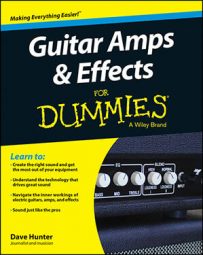This Cheat Sheet explains the three main equipment categories that comprise your music-making rig: your electric guitar, guitar amps, and effects pedals and units. These components all work together to create your sound. And because you can swap out equipment and change settings, the creative possibilities are virtually limitless.
Understanding guitar amps
Your amp is where everything gets louder. In effect, the amp takes the signal from your guitar and translates it back into sound waves in the air that your listener can hear. But even at this seemingly final stage, plenty more happens to your sound than just the “gets louder” part of the equation.
The circuitry within most guitar amps contains several stages that shape your guitar signal in a variety of ways, one after the other. This allows you to alter and enrich your guitar tone, above and beyond merely amplifying it. After your signal goes in through the input in the front of the amp, it hits:
-
A preamp stage: This stage increases its strength and also, in some cases, adds some slight distortion that enhances its texture, the way an overdrive pedal does. Many amps have multiple preamp stages.
-
A tone stage: This stage alters the signal’s frequency content somewhat, according to how you set this stage’s controls.
-
An output stage: Here, the signal is ramped up even further, ready to be pumped through an output transformer that blasts it through the speaker, but where additional body and texture is also added.
-
A speaker: The speaker pumps the signal back into the air for you to hear, and it also adds some of its own sonic character to everything that has come before.
Quick and easy ways to change your guitar tone
Have you grown bored with the way your guitar sounds? You don’t have to buy a new guitar, amp, or effects pedal to craft a fresh sound as long as your existing equipment is serviceable and of a decent quality.
Try these simple ways of mixing things up a little:
-
If you’re in the habit of playing on one pickup all the time, switch to a different one, adjusting your amps to suit, if necessary.
-
If you keep your guitar’s volume and tone controls full up, maybe dial them down a little to see what happens.
-
Turn all your amp’s controls to 0, take a few minutes to forget your usual settings, and dial in something completely different.
-
Check out some guitar forums and chat rooms to discover what settings players with the same gear as yours are using to achieve different sounds.
-
Listen closely to some music you like that’s made using a completely different rig from yours, and then try your best to replicate the sound with what you’ve got.
Ultimately, be aware that the key to sounding the way you want lies in your hands and your head more than anywhere else. The way a player attacks the strings — the nuance, dynamics, and subtleties of the playing technique — usually has a bigger influence on how he or she sounds than any other single ingredient in the rig.
Try to play mindfully, being keenly aware of the variations in sound produced when you simply play the guitar differently, and you will quickly develop an original voice.

